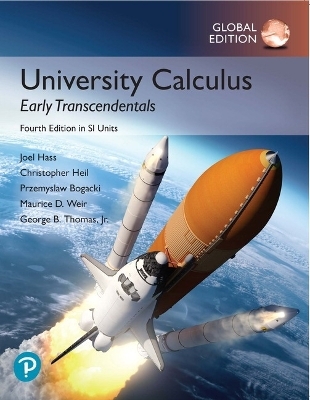
University Calculus: Early Transcendentals, Global Edition
Pearson Education Limited (Verlag)
978-1-292-31730-4 (ISBN)
University Calculus: Early Transcendentals helps students generalise and apply the key ideas of calculus through clear and precise explanations, thoughtfully chosen examples, meticulously crafted figures, and superior exercise sets. This text offers the right mix of basic, conceptual, and challenging exercises, along with meaningful applications. In the 4th SI Edition, new co-authors Chris Heil (Georgia Institute of Technology) and Przemyslaw Bogacki (Old Dominion University) partner with author Joel Hass to preserve the text's time-tested features while revisiting every word and figure with today's students in mind.
Joel Hass received his PhD from the University of California - Berkeley. He is currently a professor of mathematics at the University of California - Davis. He has coauthored 6 widely used calculus texts as well as 2 calculus study guides. He is currently on the editorial board of Geometriae Dedicata and Media-Enhanced Mathematics. He has been a member of the Institute for Advanced Study at Princeton University and of the Mathematical Sciences Research Institute, and he was a Sloan Research Fellow. Hass's current areas of research include the geometry of proteins, 3-dimensional manifolds, applied math and computational complexity. Christopher Heil received his PhD from the University of Maryland. He is currently a professor of mathematics at the Georgia Institute of Technology. He is the author of a graduate text on analysis and a number of highly cited research survey articles. He serves on the editorial boards of Applied and Computational Harmonic Analysis and The Journal of Fourier Analysis and Its Applications. Heil's current areas of research include redundant representations, operator theory and applied harmonic analysis. Maurice D. Weir holds a DA and MS from Carnegie-Mellon University and received his BS at Whitman College. He is a Professor Emeritus of the Department of Applied Mathematics at the Naval Postgraduate School in Monterey, California. Weir enjoys teaching Mathematical Modeling and Differential Equations. His current areas of research include modeling and simulation as well as mathematics education. Weir has been awarded the Outstanding Civilian Service Medal, the Superior Civilian Service Award, and the Schieffelin Award for Excellence in Teaching. He has coauthored 8 books, including the University Calculus series and Thomas' Calculus. Przemyslaw Bogacki is an Associate Professor of Mathematics and Statistics and a University Professor at Old Dominion University. He received his PhD in 1990 from Southern Methodist University. He is the author of a text on linear algebra. He is actively involved in applications of technology in collegiate mathematics. His areas of research include computer aided geometric design and numerical solution of initial value problems for ordinary differential equations.
1. Functions
1.1 Functions and Their Graphs
1.2 Combining Functions; Shifting and Scaling Graphs
1.3 Trigonometric Functions
1.4 Graphing with Software
1.5 Exponential Functions
1.6 Inverse Functions and Logarithms
2. Limits and Continuity
2.1 Rates of Change and Tangent Lines to Curves
2.2 Limit of a Function and Limit Laws
2.3 The Precise Definition of a Limit
2.4 One-Sided Limits
2.5 Continuity
2.6 Limits Involving Infinity; Asymptotes of Graphs
Questions to Guide Your Review
Practice Exercises
Additional and Advanced Exercises
3. Derivatives
3.1 Tangent Lines and the Derivative at a Point
3.2 The Derivative as a Function
3.3 Differentiation Rules
3.4 The Derivative as a Rate of Change
3.5 Derivatives of Trigonometric Functions
3.6 The Chain Rule
3.7 Implicit Differentiation
3.8 Derivatives of Inverse Functions and Logarithms
3.9 Inverse Trigonometric Functions
3.10 Related Rates
3.11 Linearization and Differentials
Questions to Guide Your Review
Practice Exercises
Additional and Advanced Exercises
4. Applications of Derivatives
4.1 Extreme Values of Functions on Closed Intervals
4.2 The Mean Value Theorem
4.3 Monotonic Functions and the First Derivative Test
4.4 Concavity and Curve Sketching
4.5 Indeterminate Forms and L’Hôpital’s Rule
4.6 Applied Optimization
4.7 Newton’s Method
4.8 Antiderivatives
Questions to Guide Your Review
Practice Exercises
Additional and Advanced Exercises
5. Integrals
5.1 Area and Estimating with Finite Sums
5.2 Sigma Notation and Limits of Finite Sums
5.3 The Definite Integral
5.4 The Fundamental Theorem of Calculus
5.5 Indefinite Integrals and the Substitution Method
5.6 Definite Integral Substitutions and the Area Between Curves
Questions to Guide Your Review
Practice Exercises
Additional and Advanced Exercises
6. Applications of Definite Integrals
6.1 Volumes Using Cross-Sections
6.2 Volumes Using Cylindrical Shells
6.3 Arc Length
6.4 Areas of Surfaces of Revolution
6.5 Work
6.6 Moments and Centers of Mass
Questions to Guide Your Review
Practice Exercises
Additional and Advanced Exercises
7. Integrals and Transcendental Functions
7.1 The Logarithm Defined as an Integral
7.2 Exponential Change and Separable Differential Equations
7.3 Hyperbolic Functions
Questions to Guide Your Review
Practice Exercises
Additional and Advanced Exercises
8. Techniques of Integration
8.1 Integration by Parts
8.2 Trigonometric Integrals
8.3 Trigonometric Substitutions
8.4 Integration of Rational Functions by Partial Fractions
| Erscheinungsdatum | 22.08.2019 |
|---|---|
| Verlagsort | Harlow |
| Sprache | englisch |
| Maße | 216 x 274 mm |
| Gewicht | 2040 g |
| Themenwelt | Mathematik / Informatik ► Mathematik ► Analysis |
| ISBN-10 | 1-292-31730-2 / 1292317302 |
| ISBN-13 | 978-1-292-31730-4 / 9781292317304 |
| Zustand | Neuware |
| Haben Sie eine Frage zum Produkt? |
aus dem Bereich


